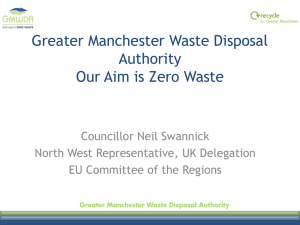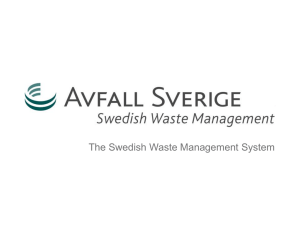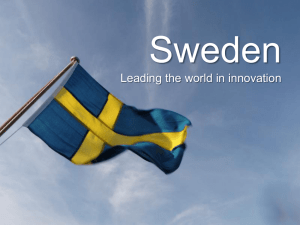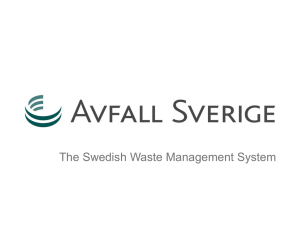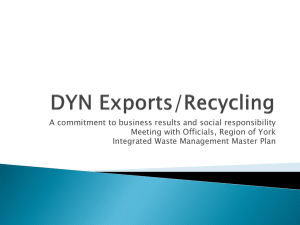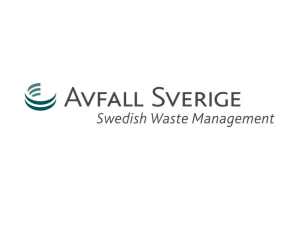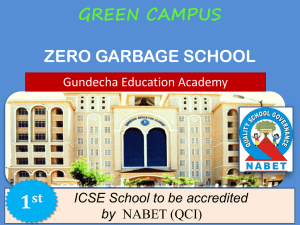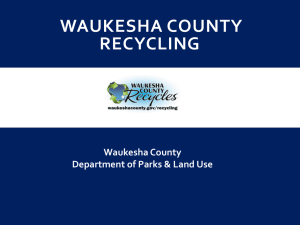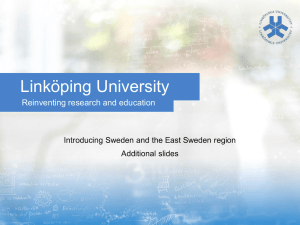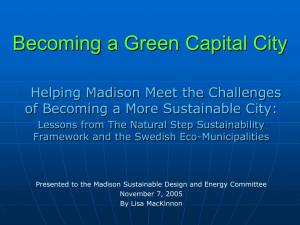Municipal waste - Avfall Sverige
advertisement
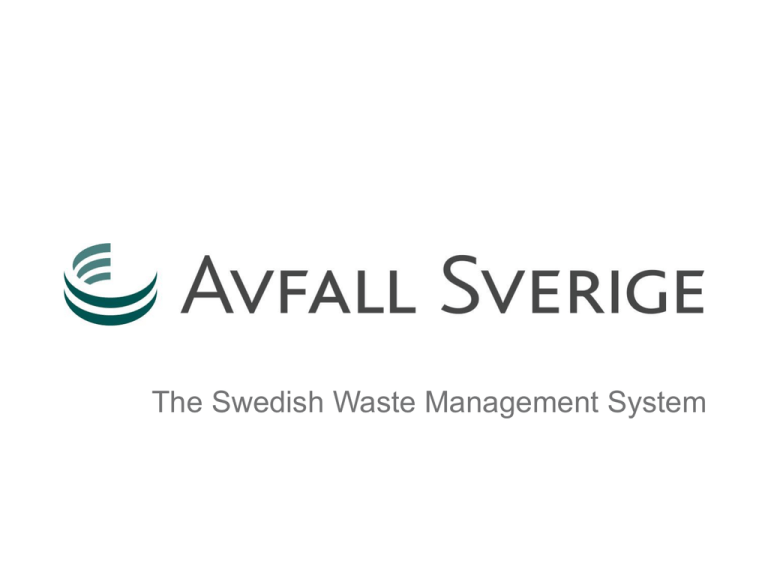
The Swedish Waste Management System Content Part 1: – Sweden – Avfall Sverige – The Swedish Association of Waste Management Part 2 – Waste – a Resource – The Development – Responsibilities – Operations Part 3 – Overview Model – Infrastructure – Collection – Recovery and Recycling Part 4 – Waste Economy – Means of Control – Success Factors – Challenges – Vision and Long Term Goals Part 5 – Waste Management on Export – A new Swedish Platform Important success factors Waste management is a public service Clear division of roles and responsibilities Clear national environmental targets showing the direction and long-term regulations and economical steering instruments Co-operation between municipalities Collaboration between public and private sectors Holistic system view- an integrated part of the sustinable city Co-operation within municipalites (Waste-, Energy-, Water-, Urban- planning-, etc departements) A system based on source separation with focus on communication and public engagement A system based on resource recovery Part 1 Sweden Avfall Sverige – The Swedish Association of Waste Management Sweden 9,5 million inhabitants 450 000 km2 Avfall Sverige The Swedish Association of Waste Management 400 members, primarily within the public sector, but also private enterprises -service providers for the Swedish citizens Networking, training and lobbying National member of Cewep, ECN, ISWA and Municipal Waste Europe Part 2 Waste – a Resource The Development Responsibilities Operations Waste - a resource Treatment of household waste in Sweden, 2012 (%) and the resources produced from it Material recycling Biological recycling Energy recovery Landfill Waste - a resource Treatment of household waste in Sweden, 2012 (%) and the resources produced from it 2012: • 14,7 TWh district energy -> 20 % of the total district energy in Sweden - the heating need of 900 000 homes • 1,7 TWh electricity – the need of 250 000 homes Material recycling Biological recycling Energy recovery Landfill 2012: • 353 GWh vehicle-fuel produced from foodwaste replaced about 30 millions liters of petrol. • 725 000 tonnes biofertilizer produced replacing industrial fertilizer Waste hierarchy Unique results 100 90 80 70 60 Material recycling 50 Biological recycling 40 Energy recovery Landfill 30 20 10 0 Sweden 2010 EU 2010 USA 2010 Towards zero landfilling - a 40 years perspective 62 % 1% Important steps of development Late 1800: Cholera-epidemic - start of municipal waste management 1950’s: District heating systems developed 1970’s and 80’s: Oil crises - waste is being used for district heating An important part of the energy system District energy in Sweden – fuel supply: Electricity Biofuels Waste heat Waste 5% Oil Heatpumps Peat Biofuels 1980 Carbon Gas Waste Oil Electricity Heatpumps Fossil fuels 1993 Waste heat Waste Peat Waste heat Biofuels 2008 Source: An important part of the energy system District energy in Sweden – fuel supply: Electricity Heatpumps Fossil fuel Waste heat Waste Peat Biofuels Source: Towards zero landfilling Household waste to landfill per year (tonnes) 1600000 50 % 1400000 Landfill tax introduced 1200000 1000000 Ban on landfill of combustible waste Producers’ responsibility introduced 800000 600000 Ban on landfill of organic waste National target on food waste recycling Municipal waste planning compulsory 400000 200000 2010 2005 2000 1995 1990 0 Clear division of roles and responsibilities Municipalities: • Collection and treatment of municipal waste Citizens/households: • Separation and leave/transport waste at indicated collection points Producers: • Collection and treatment of waste within the Producers Responsibility Companies/Indust ries: • Handling of own generated waste Plans, regulators, permissions and supervision National level Parliament National environmental targets The Swedish Environmental Protection Agency National waste plan Produces national legislation and guidelines National environmental courts (5 plus one superior): Gives permissions to larger treatment plants Regional level (21 counties) County Administrative Board - government authority: Regional environmental targets Permissions and control for most treatment plants Supervision of the regional treatment capacity Municipal level (290 municipalities) Municipal authorithies: Local environmental targets Local waste plans and regulations Permissions and control of smaller treatment plants Organisation and operation Municipalities deal with their responsibility in different ways and design their own waste management organisation Organisation: About 50 % municipal companies Collection: 73 % outsourcing (mainly to private companies) Treatment: About 65% outsourcing (mainly to municipal companies) Owner-ship of waste incinerators Municipally owned plant – Co-owned regional waste company (2 out of 32) – Full-owned energy company – Full-owned multi-utility company Privatly owned plant (4,5 out of 32) Clear division of roles and responsibilities Responsibility Municipalities Citizens/hous eholds Producers Implementation and operation Private and public waste management sector • Knowledge- and Equipment supply Companies /Industries • Treatment- and Collection services Co-operation Co-operation – the solution to an increasingly complex waste management Thru • Common municipal waste company (20 regional companies in Sweden) • Common municipal waste association (8 associations in Sweden with totally 28 municipalities) • Common board (4 common boards in Sweden with totally 9 municipalities) • Common procurement on specific issues matters Part 3 Overview Model Infrastructure Collection Recovery and Recycling Overview model Housholds or companies Waste prevention New products: Biogas, new materials, district heating, electricity, bio-fertilizer Collection and transport Recycling stations Recycling centers Curbside collection Materialrecycling Biological recycling Energy recovery Landfill Public awarness - a success factor Key messages and tools for motivation and to facilitate collaboration: – Communication – Development of self instructive systems – Feed back of the results and that ”what I do matters” – Emphasize on the waste holders responsibility and participation Waste prevention Long tradition of reuse through flea markets, second hand, collection at recycling parks, etc Deposit fee system for bevarage containers/bottles Foodwaste, textiles, electronical and demolition waste in focus – goals proposed Largest challenge: decoupling between generated waste and economic growth Resource recovery focus Quality Source separation Resource recovery focus Quality Source separation Secure handling of hazardous waste Infrastructure Collection of waste from households based on source separation Curb side collection 5 800 unmanned recycling drop-off stations 630 manned drop-off recycling centers Treatment and recycling of waste based on the charcter of the waste 60 organic waste facilities 34 waste to energy plants 78 landfills Collection Collection of waste from households based on source separation Curbside collection for combustible and food waste (and sometimes packaging and paper) 5 800 unmanned recycling drop-off stations for for packaging and paper 630 manned drop-off recycling centers for bulky, electronical and hazardous waste Various solutions for hazardous waste collection Innovation and trends in collection Multi compartment collection vessels Optical sorting Vehicles on biogas Automated vacuum systems Underground containers Infrastructure Treatment and recycling of waste based on the character of the waste 60 organic waste facilities 34 waste to energy plants 78 landfills Recycling centers A system based on resource focus Materials Food waste Products Biogas Biofertilizer Virgin materials and energy saved Petrol saved and industrial fertilizer saved Combustible waste District energy Electricity Fossil and other fuels saved Hazardous waste Direct environmental benifit Environmental protection costs saved A system based on resource focus Materials Food waste 2012: Products • Biogas Biofertilizer 353 GWh vehicle-fuel produced from foodwaste replaced about 30 millions liters of petrol. • 725 000 tonnes Virgin materials Petrol saved and biofertilizer produced and energy saved industrial fertilizer replacing industrial saved fertilizer Combustible waste Hazardous waste 2012 District Electricity Direct • 13 TWh district energy energy environmental > 20 % of the total benifit district energy in Sweden / the heating need of 900 000 homes Fossil and other • 1,7 TWh electricity -> fuels saved need of 250 000 homes Environmental protection costs saved Production of biogas and bio-fertilizer The most increasing treatment method 58 plants Energy recovery by the production of biogas used as a vehicle-fuel Recycling of nutritions to farming-land by the production of bio-fertilizer During 2012, 353 GWh vehicle-fuel was produced from foodwaste replacing about 30 millions liters of petrol. 725000 tonnes biofertilizer is produced yearly in Sweden. Generation of district heating and electricity Covers around 20 % of the total district heating in Sweden, equals the needs of 900 000 homes Produces electricity corresponding to the needs of 250 000 homes Advanced and secure flue gas treatment Most of the rest-products can be recycled Total energy production 2012: District heating: 13 TWh Electricity: 1,7 TWh (including industral waste) Energy recovery of waste 34 plants: Receiving 50 000 – 700 000 tonnes yearly (2012: 32 plants) Recovering yearly (2012: 32 plants) – totally 5 042 000 tonnes – of which 2 270 000 tonnes municipal waste Gate fee approx 370-710 SEK/tonnes (average 500 SEK) The most energy efficient plants in the world Recovered energy per tonne household waste incinerated 3,0 MWh/ton Electricity Heat 2,5 2,0 1,5 1,0 0,5 0,0 If industrial waste was included in the diagram the Swedish result would be almost 3 MWh/tonnes Efficient and clean waste incineration Clean waste incineration Most emissions decreased with 90-99 % since 1985: – Strict emission regulations – Fee on NOx (nitrooxygen) Reduced weight and volume • 15-20 weight% bottom ash • 3-5 weight% fly ash From landfills to modern recycling facilities (Illustrator: Per Josefsson) An integrated part of a holistic system Products Households Material recycling Farms Sewage water cleaning Biosolids Waste Anaerobic digestion Vehicle fuel Landfill Incineration Biogas Other fuels Cooling/ heating production Electricity production Part 4 Waste Economy Means of Control Success Factors Challenges Vision and Long Term Goals Waste economy Municipal waste: All costs covered by municipal waste fees (not by taxes) The fee is decided by each municipal board Non-profit Allowed to be differentiated to encourage source separation for recycling Municipal waste within producers’ responsibility: Costs covered by a fee added to the price of every product The fee is decided by the producers Waste fee Average yearly fee per household 2011: • Houses: 220 EUR • Flats: 140 EUR Average daily fee per household Costs for municipal waste management Administration and information Curb side 14% collection, bulky waste 1% Recycling centers, including hazardous waste 28% Others 4% Curb side collection, residual waste 31% Treatment, residual waste 22% Cost for municipal waste management, 2010, average Means of control Environmental objectives Government regulations, bans, and taxes, for example: Tax on landfilling (since 2000) Ban on landfilling of combustible waste since 2002 Ban on landfilling of organic waste since 2005 Differentiated municipal waste tariffs Municipal waste planning and regulations Information and communication Important success factors Material recycling Biological recycling Energy recovery Landfill Waste management is a public service Clear division of roles and responsibilities Clear national environmental targets showing the direction and long-term regulations and economical steering instruments Co-operation between municipalities Collaboration between public and private sectors Holistic system view- an integrated part of the sustinable city Co-operation within municipalites (Waste-, Energy-, Water-, Urbanplanning-, etc departements) A system based on source separation with focus on communication and public engagement A system based on resource recovery Generated household waste in Sweden is predicted to double 2010-2030 (Swedish EPA) Generated waste world wide is predicted to rise with 72 % 2010-2025 (What a Waste-A global review of Solid Waste Management, mars 2012, World Bank Group) Avfall Sverige’s vision Zero waste! Long-term goals until 2020: Decoupling between generated waste and economic growth Economic growth Strong upward movement in waste hierarchy Generated waste BN P Part 5 Waste Management on Export – A new Swedish Platform Swedish Waste Management on Export A new Swedish platform built on co-operation between the public and private waste management sector SosExpo Warszawa Mars 2013 Aim with the new platform To facilitate the export of Swedish knowledge about waste management, products and services within the waste sector, through cooperation among the public and the private waste management sector. A strategy based on cooperation A network of actors in the public and private waste management sector in Sweden: - Municipalities/municipal companies - Knowledge suppliers - Technlogy suppliers A strong Swedish platform with a unique mix of competences Swedish Waste Management on Export Contact and information Project leader: Jenny Åström jenny.astrom@avfallsverige.se +46-70-5136612 • Information about swedish waste management in english : www.avfallsverige.se/in english • Information about the national platform for export of knowledge and technology: www.avfallsverige.se/in-english/export
